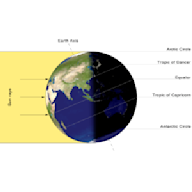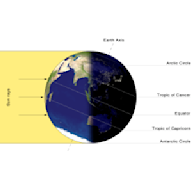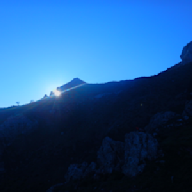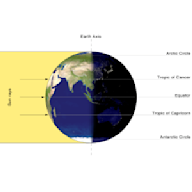Search results
Earth during the summer solstice in June 2017. The summer solstice or estival solstice occurs when one of Earth's poles has its maximum tilt toward the Sun.It happens twice yearly, once in each hemisphere (Northern and Southern).For that hemisphere, the summer solstice is the day with the longest period of daylight and shortest night of the year, when the Sun is at its highest position in the sky. At either pole there is continuous daylight at the time of its summer solstice. The opposite ...
Astronomical summer begins at the summer solstice, which is the longest day of the year. This means days get shorter during summer—very slowly at first, but at ever-larger daily intervals as the September equinox approaches, heralding the start of fall. Locations closer to the poles experience larger differences in day length throughout the year, so summer days are longer there.
The June solstice marks the start of summer in the Northern Hemisphere and the start of winter in the Southern Hemisphere, according to one definition. Equinox and solstice dates—years 1-2149. Sunrise and Sunset Times Lag Behind. The longest day of the year is commonly associated with the earliest sunrise and latest sunset of the year.
Jun 28, 2024 · Summer solstice, the two moments during the year when the path of the Sun in the sky is farthest north in the Northern Hemisphere (June 20 or 21) or farthest south in the Southern Hemisphere (December 21 or 22). Learn more about the summer solstice in this article.
May 17, 2024 · Why does the summer solstice date vary? Each year, the summer solstice in the Northern Hemisphere falls on one of two days: June 20 or June 21. In the Southern Hemisphere, the summer solstice ...
Sep 26, 2022 · The summer solstice marks the official start of astronomical summer and the longest day of the year. It occurs when one of Earth's poles is tilted toward the sun at its most extreme angle, and due ...
Aug 10, 2017 · The summer solstice is the longest day of the year, and the shortest night. In the Northern Hemisphere it takes place between June 20 and 22, depending on the year. In 2024, the summer solstice ...
Jul 8, 2024 · This solstice marks the official beginning of summer in the Northern Hemisphere, occurring when Earth arrives at the point in its orbit where the North Pole is at its maximum tilt (about 23.5 degrees) toward the Sun, resulting in the longest day and shortest night of the calendar year.
In the Southern Hemisphere, June is winter and December is summer. On the date of the summer solstice, all locations in that hemisphere experience their longest days and shortest nights. The winter solstice produces the shortest days and longest nights. Earliest sunrise not on longest day. Equinoxes and Solstices on Other Planets. Every planet in the solar system, apart from Mercury, is tilted on its axis of rotation. This means each planet has its own equinoxes and solstices.
Summer beckons us all year long with the promise of swimming pools, ice cream trucks, and relaxing in the shade. For the Northern Hemisphere, the official summer season starts on June 20 or 21 ...





